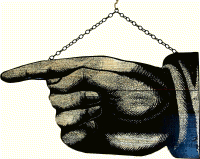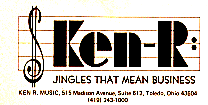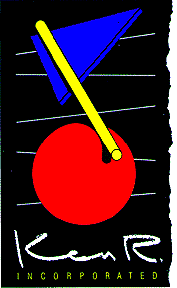
|

Ken R Inc. & Ken R LLC
Toledo, Ohio, USA.
1977-2005
|

|
Ken R: All Jingles All the
Time
If the entire world of jingles were represented
by a large plate of Mexican food, my company, Ken R. LLC, would
be a very small enchilada.
My life story was covered in excruciating detail in "The
Jingle Book," "Up and Down the Dial" and "The
Second Jingle Book," which are available in e-form as downloads
from www.danoday.com.
Thus, I'll skip the recap and get to some more interesting dish
on running my own company (1977-2005, may it rest in peace).
Other People Did
it Better
My biggest jingle influence was the original incarnation of PAMS.
I had the chance to visit there five or six times during the 1970s.
This company was the gold standard for jingles in the 1960s. In
fact many program directors built their slogans and programming
around those packages. Other favorites are JAM which is still run (after more than 30
years) by my longtime friend Jon Wolfert, and TM, which produced
some kick-ass jingles between about 1969 and 1977. The writing,
arranging and clever production techniques from those companies
made life worth living for me. It was always a trip to tune around
the AM dial at night and pick up the latest jingles from Chicago,
New York and other cities.
Back to the jingle companies.
While Bill Meeks at PAMS was primarily a salesman who had
an eye for hiring great talent, Tom Merriman (who founded
CRC and later co-founded TM) is one of the few people to whom
the term "musical genius" can be applied. Meeks died
in 1999; Tom Merriman is still writing music every day. Both of
these men were pioneers whose careers go back to playing in and
arranging for big bands in the late 1940s.
Bob Piper worked at PAMS from 1967 through the early 70s,
then continued at TM. (He even wrote a bunch of jingles for my
company later.) His humility and musical versatility were what
I remember about him. Bob Piper died in 1994 but his son and wife
both are still active in music.
Jon Wolfert is a jingle "renaissance man." He
writes, arranges, mixes, deals with clients, assembles wizard
demos and is able to stay awake all night to get it done if needed.
He should be put in the history books not just for keeping it
all going for so many years, but for doing so many things so well.
The fact that he is a quiet, funny, family man is less well known
in the business.
What about Ken?
My own story is much more mundane. After a couple of years of
college at the University of Michigan, I kicked around several
small and medium sized radio stations from 1971-1976. I was a
mediocre air talent, an inept program director and a moderately
successful talk host. Then I had a disastrous year directing TV,
a job for which I had no aptitude and no desire. It was not a
wonderful time, although I worked with some terrific people.
I always loved ID jingles and swapped tapes with people like Jon
Wolfert, Ken Justiss and Ron Harris (both of whom later worked
for TM and other companies). At that time the jingle collecting
world consisted of about six people, a very exclusive and geeky
group. We loved to surprise each other with our acquisitions and
debated the relative merits of various packages in tape letters
which we sent each other. During this period we all compiled what
we called samplers, which were audio montages of our favorite
jingles. Ron Harris was the king of this art, injecting irreverent
humor into everything he created. He was the "splice wizard"
as computers were at least 20 years in the future. Collecting
was made a bit more difficult because every time we copied a jingle
package, the fidelity got a little worse. We tried to get the
best possible dubs of everything directly from the jingle producers
whenever possible. Jon Wolfert got a job at PAMS in 1971, which
gave us access to some pretty amazing stuff we had only dreamed
about.

In 1977 I decided to start a jingle/radio production company and
named it Ken R. Music. We started off primarily recording commercial
jingles for shopping centers, car dealers, banks and other retailers.
In 1980 we changed the name to Ken R. Incorporated, and through
a series of illogical events detailed in my books, I ended up
with "The PAMS Tapes." These included what our U.K.
friends call the "backing tracks," or instrumental backgrounds
for the IDs and commercials, and about 3500 mono and stereo reels
of station jingles. All these tapes had been seized by the I.R.S.
a few years earlier after PAMS went out of business in 1978. My
acquisition of these tapes spun me in a new direction.
I had been recording my own instrumental tracks in Toledo, Ohio
and having them sung in Dallas at various studios using Jon Wolfert
and Tommy Loy (another engineering whiz who is unfortunately deceased)
to record whichever singers I needed at the time. After I got
the PAMS tapes I began to put together my own vocal group in Toledo,
a city which previously had no jingle industry. I lucked out and
found Lisa Young and Doug Nichol right away, two incredibly talented
singers who stuck with me for the next 20+ years. The other singers
(Ben Ayling, DJ Hiner and Amy Lentner) joined us over the next
few years so that we were able to build a very credible and versatile
group. We began to experiment with singing new ID jingles over
the PAMS instrumental tracks.
Enter Ben Freedman. Ben had dabbled in jingles and was primarily
a salesman. He had no musical training, but was able to communicate
what he wanted. Ben began to sell our jingles and suddenly we
were cranking out PAMS (and our own original) jingles for England,
Ireland, the Netherlands and lots of cities in the USA. We were
also singing tracks he produced such as "Mainstream."
Over the years, other companies would send us their tracks to
sing, too. I never made much money singing for Ben, but my commercial
jingles paid most of the bills as I built my studio. In 1984 I
moved into a bigger facility with lots of room and found myself
with a secretary and an engineer on the payroll. Things began
happening as we picked up clients like United Airlines, Pizza
Hut and the Wall Street Journal.

I gradually taught
myself to write vocal charts in the PAMS style, something which
was not easy for me, even though I had ten years of classical
piano training. Writing five-voice or seven-voice vocal charts
is an obscure art and there was no text book. I studied everything
I could from CRC, PAMS, Gwinsound, Hugh Heller Corporation, even
Pepper Tanner, to find out how they achieved their vocal blend.
I also had to teach myself how to engineer and mix, never my areas
of expertise. I learned a little bit more with each jingle. By
1990, I can say that our sound was well accepted around the world.
My plan was to make PAMS re-sings affordable not just to radio
stations, but to individual collectors. Many of the latter bought
hundreds of their own jingles which were always fun to produce.
The singers and I greatly enjoyed these sessions. Below is a random
selection, of our work, more will follow as time permits.
In 1996 I had a parting
of the ways with Ben in an expensive legal explosion which is
described in detail on the PAMS Web site. I was still producing
PAMS jingles, but now under license from Jon Wolfert who had paid
the back taxes of the original PAMS and was operating a company
called PAMS Productions Inc. (in addition to his work at JAM Creative
Productions). He used the tracks to produce Dallas vocals and
he allowed me to use my Toledo group to produce re-sings. Ben
formed Ben Freedman Productions and sold Gwinsound re-sings.

A world of collectors
Other things had been happening behind the scenes. Beginning in
1987 I started restoring the thousands of reels of PAMS reference
dubs (copies of ID packages for WABC, WLS and other stations)
which I had purchased. These were preserved on DAT, a horrible
format that had to do until CD recording became affordable. We
transferred almost 400 two-hour DATs of the PAMS archives. This
was something I did for my own pleasure, never imagining I would
ever make a dime with them. I just wanted to save the jingles
before the old tape reels disintegrated.
In 1996 I got a call from a collector in New York who asked if
I would sell him some of the WABC PAMS jingles on a CD. By this
time I had a SADiE workstation and my own CD burner (which cost
$2500 at the time!). I made a compilation of 99 jingles called,
"Best of WABC" which included some of the All American
and Jet Set jingles (PAMS 26 and 27). The collector was delighted
so I offered it to others, eventually selling over 300 copies
of that CD. It was the first of more than 500 compilation CD products
I would create and sell to a burgeoning network of jingle fanatics
around the world. Other big sellers were "WLS: The 60s,"
"WLS: the 70s" and "KFWB Channel 98." I would
like to claim that there was some executive long-range planning
involved here but it was all quite accidental.
About this time a fellow named Norman Barrington came into my
life. He was a former broadcaster residing in Scotland who made
his living designing Web sites. For a long time he asked if he
could set one up for me. In 1996 I could no longer think of any
reasons not to. This was a turning point in my business and I
must give credit to Norman for constantly dreaming up elegant
and creative ways to get my message out over the Internet.
Since selling jingles on CD worked well with PAMS, I formed other
alliances. I contacted musical legends Anita Kerr and Johnny Mann,
both of whom were amazed that anyone cared about their jingles.
They each gave me permission to sell their products, many of which
they were able to provide me excellent copies of. I began sending
them checks every month as sales rolled in.

I got permission to sell pre-1980 TM and older CRC, Futursonic
and Spot jingles. Since Pepper Tanner was gobbled up by TM, the
Memphis sound became a part of my catalog. Gradually we had over
1200 collectors around the world, dozens of whom bought every
single CD we could produce. We cranked out about 15 new collector
CDs four times a year between fall 1996 and May 2005.
But the jingle business itself had changed. Singers were demanding
more money. Radio station budgets were getting tighter since the
1996 FCC rule which allowed radio groups in the U.S. to own hundreds
of stations each. The Internet was not yet the force it is today,
so it was still expensive to create and send out thousands of
CD demos. More jingle companies were popping up. Commercial jingles
were now being sold differently, in wholesale lots of 10 and 20
at a time to radio sales managers by jingle gypsies like Otis
Conner. In short, the business model was changing to the point
where I began to look for an exit door.
Adding to my desire to change careers was the burn-out factor.
We were holding a vocal session every Monday night. I would mix
jingles Tuesday and Wednesday. On Thursday and Friday I would
begin writing the 40 or so vocal charts I would need for the next
Monday night's session. This went on week in and week out for
years and it was ruining my health. Unfortunately I do not have
the stamina or patience of someone like Jon Wolfert. I needed
a lot more sleep. I was trying to be a one-man show and it was
slowing killing me.
In 1999 I told my wife I was getting off the merry-go-round and
selling my studio. She breathed a sigh of relief. I told Jon Wolfert
when he visited Toledo in September of that year. The next week
I sat down with my office staff and singers and told them of my
decision. My plan was to cease production of new jingles, buy
a small office in Maumee (a suburb of Toledo) and only continue
to sell classic jingles to collectors. My secretary Brooke agreed
to come along with me. She ended up working for me for about ten
years in all. At this time we changed the name of our business
one last time, to Ken R. LLC.
With a smaller operation, lower overhead and less pressure, I
thrived. We sold thousands of CDs each year beginning in spring,
2000. We had collectors in Japan, the Netherlands, England and
every state in the U.S. It was rewarding emotionally and financially…
and I was only working about five hours a day instead of ten.
Heaven!
Somewhere in there I wrote three books, which was a wonderful
learning experience. The two books about jingles each sold hundreds
of copies, depleting my stock before expected.
The CD business continued until 2005 when I decided I had taken
it as far as I could. Everything worth putting on CD from those
great jingle companies of the past was out there. I felt the market,
while not saturated, was beginning to wane and I just had no new
material to release. Thus I decided to "retire" in spring
of 2005. I held one last three-month sale during which we sold
many thousands of CDs, PAMS posters, PAMS T-shirts, PAMS coffee
mugs and much more. I got hundreds
of e-mails, letters and calls from collectors who begged me to
keep going… but I knew it was time to exit. I sold my
condo/office that spring and went into a life of ease for a while.
In the present
Since 1984 I had been writing on a freelance basis for a number
of publications including Radio World. I really kicked that into
high gear after 2000, seeing about 50 articles a year published
in RW and other magazines. I now do even more of that, and I'm
returning to college after an absence of 34 years, to finish my
bachelor's degree in communication. In my spare time I restore
audio (vinyl and tapes) with sophisticated software from CEDAR
and SADiE. And I keep writing. All of these activities are chronicled
at www.kenr.com,
my site which Mr. Barrington continues to manage for me.
I enjoyed every moment of my jingle career. Meeting and interviewing
the real stars of the business for my jingle books was a delight.
And seeing so much acceptance for classic jingles from the 60s
and 70s warmed my heart.
At age 55 I now need to decide what I'm going to do when I grow
up.
Ken R, Toldeo, May 2006
-----------------------------------
Norman's Note: Although
Ken is very modest about his own jingle operation, compared to
the big companies, he has contributed greatly to the jingle enthusiast
fraternity around the world, by being amongst the first to trade
jingles in the 1960s, producing great 'samplers' which became
a tradition amongst collectors, then by rescuing classic Pams
material that would otherwise have been erased, and finally being
the only person to sell collector items, and resings and at price
everyone could afford. It has been a delight to work with him,
over the last ten years, and I would like to point out that my
own collection here, is of world class, primarily because of his
generous contributions over that time. It was a bonus that he
was able to visit me here in Scotland last year, our first ever
meeting in the flesh.
On behalf of the Jingle
Collectors everywhere, Ken, Thank You.

|